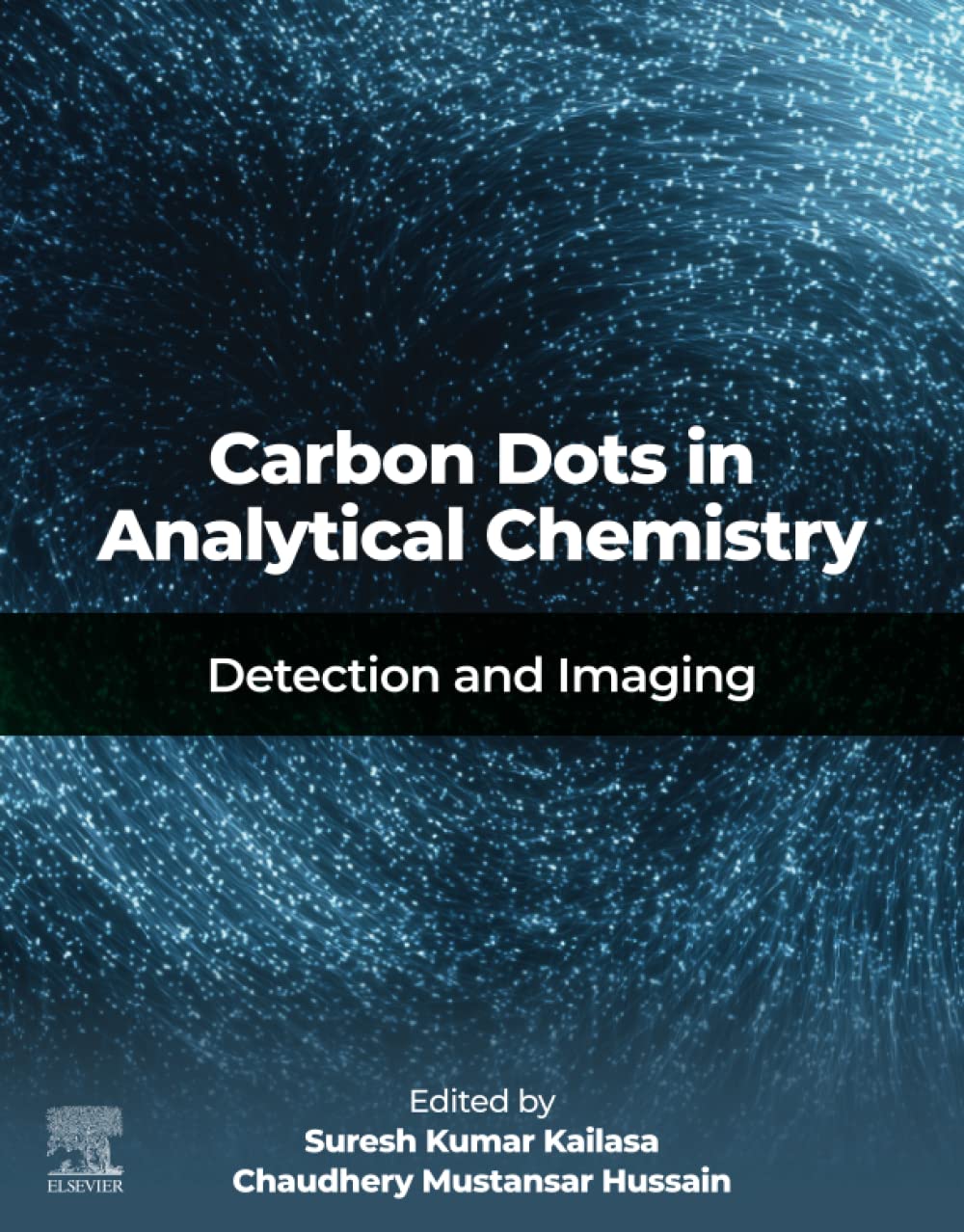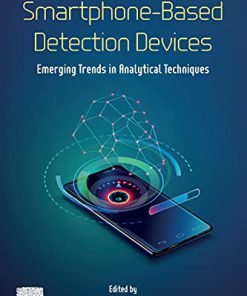Carbon Dots in Analytical Chemistry Detection and Imaging 1st Edition by Suresh Kumar Kailasa, Chaudhery Mustansar Hussain 9780323985734 0323985734
$50.00 Original price was: $50.00.$25.00Current price is: $25.00.
Carbon Dots in Analytical Chemistry Detection and Imaging 1st Edition by Suresh Kumar Kailasa, Chaudhery Mustansar Hussain – Ebook PDF Instant Download/Delivery:9780323985734, 0323985734
Full download Carbon Dots in Analytical Chemistry Detection and Imaging 1st Edition after payment

Product details:
ISBN 10: 0323985734
ISBN 13: 9780323985734
Author: Suresh Kumar Kailasa, Chaudhery Mustansar Hussain
Carbon Dots in Analytical Chemistry: Detection and Imaging explores recent progress in the field of carbon dots synthesis and properties and their integration with various miniaturized analytical devices for the detection of chemical species and imaging of cells. This book is dedicated to exploring the potential applications of carbon dots in analytical chemistry for clinical microbiology, pharmaceutical analysis and environmental analysis. Sections cover synthetic approaches and properties, sample preparation, analytical techniques for the detection of chemical species, imaging of molecules and cells, and analytical tools for biomedical and food analysis.
The will be a valuable book for analytical and materials scientists, physical and chemical scientists, and engineers investigating the use of carbon nanomaterials in their analytical procedures.
- Provides basic knowledge on the preparation and properties of carbon dots and their uses to remove toxic chemical species
- Integrates knowledge from the fabrication, mechanics, materials science and reliability points-of-view
- Covers carbon-dot-based optical methods for assaying trace-level target analytes
Carbon Dots in Analytical Chemistry Detection and Imaging 1st Table of contents:
Chapter 1. Synthetic strategies toward developing carbon dots via top-down approach
Abstract
1.1 Carbon dots—introduction
1.2 Conclusion
References
Chapter 2. Bottom-up approaches for the preparation of carbon dots
Abstract
2.1 Introduction
2.2 Bottom-up approaches for the fabrication of CDs
2.3 Conclusion and future perspectives
References
Chapter 3. An overview of optical, physical, biological, and catalytic properties of carbon dots
Abstract
3.1 Introduction
3.2 Optical properties of CDs
3.3 Physical properties of CDs
3.4 Biological properties of CDs
3.5 Catalytic properties
3.6 Effect of doping
3.7 Conclusion and future perspectives
References
Chapter 4. Characterization of carbon dots
Abstract
4.1 Introduction
4.2 Structure of CDs
4.3 Surface passivation and functionalization of CDs
4.4 Doping in CDs
4.5 Purification of CDs
4.6 Characterization techniques of CDs
4.7 Conclusions
References
Chapter 5. Carbon dots in sample preparation
Abstract
5.1 Introduction
5.2 Applications of carbon dots in sample preparation
5.3 Conclusions
References
Chapter 6. Carbon dots in separation science
Abstract
6.1 Introduction
6.2 Properties of carbon dots related to separation processes
6.3 Applications
6.4 Conclusion and future prospects
Conflict of interest
References
Chapter 7. Carbon dots for electrochemical analytical methods
Abstract
7.1 Introduction
7.2 Carbon dots: synthesis and properties
7.3 Carbon dots for electrochemical measurements
7.4 Electrochemical sensing for metal and anionic ions using carbon dots–based materials
7.5 Electrochemical sensing for H2O2 using carbon dots–based materials
7.6 Electrochemical sensing for organic-based analytes using carbon dots–based materials
7.7 Advantages of carbon dots–based electrodes
7.8 Conclusion
References
Chapter 8. Carbon dots-based fluorescence spectroscopy for metal ion sensing
Abstract
8.1 Introduction
8.2 Synthesis of carbon dots
8.3 Metal ions detection
8.4 Carbon dots as fluorescence probe for the detection of biological metal ions
8.5 Carbon dots as fluorescence probe for toxic metal ions
8.6 Carbon dots as fluorescence probe for precious metal ions
8.7 Conclusions
References
Chapter 9. Carbon dots-based fluorescence spectrometry for pesticides sensing
Abstract
9.1 Introduction
9.2 Carbon dots–based fluorescence spectrometry for pesticides sensing
9.3 Conclusions and future perspectives
References
Chapter 10. Carbon dots-based electrochemical sensors
Abstract
10.1 Introduction
10.2 Properties of graphene quantum dots and carbon quantum dots
10.3 Applications to biosensing
10.4 Conclusions and key challenges to address
10.5 Future signs
References
Chapter 11. Recent advancements of carbon dots in analytical techniques
Abstract
11.1 Introduction
11.2 Carbon dot–assisted enzyme-linked immunosorbent assay
11.3 Carbon dot–assisted surface-enhanced Raman spectroscopy
11.4 Carbon dot–assisted paper-based analytical devices
11.5 Carbon dots in chemiluminescence
11.6 Carbon dots for pH-responsive fluorescence sensors
11.7 Carbon dot–based nanothermometers to sense temperature
11.8 Matrix-assisted laser desorption/ionization time-of-flight mass spectrometry
11.9 Summary and future perspectives
References
Chapter 12. Carbon dots in hydrogels and their applications
Abstract
12.1 Introduction
12.2 Preparation of carbon dots composite hydrogel
12.3 Properties of carbon dots composite hydrogel
12.4 Emerging applications of carbon dots composite hydrogel
12.5 Conclusion
Acknowledgment
References
Chapter 13. Carbon dots as adsorbents for removal of toxic chemicals
Abstract
13.1 Introduction
13.2 Synthesis methods of carbon dots
13.3 Purification methods of carbon dots
13.4 Characterization techniques for identification of carbon dots and implication of them for various applications
13.5 Applications of carbon dots
13.6 Conclusion and future perspective
Acknowledgments
References
Chapter 14. Heteroatom/metal ion-doped carbon dots for sensing applications
Graphical abstract
Abstract
14.1 Introduction
14.2 Synthesis of heteroatom-doped carbon dots
14.3 Dopant
14.4 Single atom doping
14.5 Multiatom co-doping
14.6 Properties of heteroatom-doped carbon dots
14.7 Heteroatom-doped carbon dots as sensors
14.8 Conclusion and future challenges
References
Chapter 15. Analytical applications of carbon dots in forensics, security, and other related fields
Abstract
15.1 Forensic science
15.2 Techniques involved in forensic analysis
15.3 Nanoforensics
15.4 Carbon quantum dots: forensic applications
15.5 Challenges on the carbon dot-based analytical methods for forensic analysis
15.6 Conclusion
References
Chapter 16. Carbon dots as smart optical sensors
Abstract
16.1 Introduction
16.2 Fluorescence-based sensing of trace amount of water
16.3 Carbon dots with red emission for dual sensing of In3+ and Pd2+ in water
16.4 Fluorescent carbon nanoparticles for sensing synthetic food colorant
16.5 Concluding remarks
References
Chapter 17. Synthesis of carbon dots from waste materials: analytical applications
Abstract
17.1 Introduction
17.2 Materials and methodologies
17.3 Characterization
17.4 Applications
17.5 Conclusion
References
Chapter 18. Carbon dots as an effective material in enzyme immobilization for sensing applications
Abstract
18.1 Introduction
18.2 Methods of enzyme immobilization
18.3 Enzyme–carbon dots physiochemical mechanisms: a synergistic effect
18.4 CDs-based enzymatic biosensors
18.5 Advantages of enzyme immobilization
18.6 Enzyme immobilized carbon dots for sensing applications
18.7 Current challenges
18.8 Conclusion
Acknowledgement
References
Chapter 19. Ultra-small carbon dots for sensing and imaging of chemical species
Abstract
19.1 Introduction
19.2 Ultra-small CDs for sensing chemical species
19.3 Ultra-small CDs: functionalization and imaging applications
References
Chapter 20. Carbon dot-based microscopic techniques for cell imaging
Abstract
20.1 Fluorescence microscopic techniques for carbon dot–based cell imaging
20.2 Carbon dots as fluorescent nanoprobes for cell imaging
20.3 Carbon dots as smart nanoprobes for diverse targeted cell imaging
20.4 Conclusions
References
Chapter 21. Carbon nanomaterials-based diagnostic tools
Abstract
21.1 Introduction
21.2 Carbon nanotubes
21.3 Carbon dots
21.4 Other carbon-based nanomaterials
21.5 Conclusion and future perspective
References
Chapter 22. Carbon dots in food analysis
Abstract
22.1 Introduction
22.2 Analytical applications of carbon dots in food matrix
22.3 Summary and trends
References
Chapter 23. Multicolor carbon dots for imaging applications
Abstract
23.1 Introduction
23.2 Bioimaging
23.3 Quantum yield
23.4 Bioimaging agents for in vivo and in vitro imaging
23.5 Bioimaging applications
23.6 Conclusion and futuristic roadmap
Acknowledgment
Conflict of interest
References
Chapter 24. Synthesis and applications of carbon dots from waste biomass
Abstract
24.1 Introduction
24.2 C-dot synthesis from waste biomass
24.3 Methods for the synthesis of C-dots from biomass waste
24.4 Properties of C-dots derived from biomass waste
24.5 Factors affecting properties of C-dots
24.6 Biosynthesis of CDs from waste biomass
24.7 Conclusions and future outlook
References
Chapter 25. White light generation and fabrication of warm light-emitting diodes using carbon nanodots and their composites: a brief overview in this odyssey
Abstract
25.1 Introduction
25.2 White light generation and warm white light-emitting diodes
25.3 Designing white light-emitting diodes with carbon nanodots and their composites
25.4 Applications of white light-emitting diodes in analytical/biomedical sciences
25.5 Challenges in white light-emitting diode–based carbon nanodots
25.6 Conclusion
Acknowledgement
References
Chapter 26. Catalytic applications of carbon dots
Abstract
26.1 Introduction
26.2 Carbon dot photocatalysts
26.3 Catalytic applications
26.4 Summary and future prospects
People also search for Carbon Dots in Analytical Chemistry Detection and Imaging 1st :
carbon dots in analytical chemistry detection and imaging
what are carbon dots
what is a dot diagram in chemistry
how does a chemistry analyzer work
Tags:
Suresh Kumar Kailasa,Chaudhery Mustansar Hussain,Carbon Dots
You may also like…
Medicine
Detection of Drug Misuse Biomarkers Analytical Advances and Interpretation 1st Edition Rohrig
Uncategorized
Computers - Networking
Chemistry - Analytical Chemistry
Physics - Solid State Physics
Handbook of Particle Detection and Imaging by Claus Grupen 3642132707 9783642132704
Uncategorized
Uncategorized











